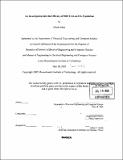An investigation into the efficacy of MRI T2 in an OA population
Author(s)
Dray, Nicole
DownloadFull printable version (15.64Mb)
Other Contributors
Massachusetts Institute of Technology. Dept. of Electrical Engineering and Computer Science.
Advisor
Deborah Burstein.
Terms of use
Metadata
Show full item recordAbstract
Several in vitro studies have shown that T2 is sensitive to some of the pathologic changes that occur in osteoarthritis (OA) such as hydration and the subsequent changes in macromolecular concentration, macromolecular structure, and tissue architecture. In this in vivo analysis, several techniques such as mean T2 and new techniques such as threshold analysis were used to determine if they could differentiate level of OA based on radiographic metrics such as the Kellgren/Lawrence scale (K/L) and Joint Space Grade (JSG) and delayed gadolinium-enhanced MRI of cartilage (dGEMRIC). In general, mean T2 in various regions of interest, normalized T2 as a function of distance from the bone, z score, comparison with dGEMRIC index, and threshold analysis were unable to differentiate between the level of OA or accurately represent important features in the images. In these OA images, the main features that appeared with disease were T2 mottling and both low and high lesions. Because of these heterogeneities in T2, none of the techniques presented in this investigation lead to conclusive results, and further work needs to be done for T2 to be diagnostic in an OA population.
Description
Thesis (M. Eng. and S.B.)--Massachusetts Institute of Technology, Dept. of Electrical Engineering and Computer Science, 2005. Includes bibliographical references (leaves 87-88).
Date issued
2005Department
Massachusetts Institute of Technology. Department of Electrical Engineering and Computer SciencePublisher
Massachusetts Institute of Technology
Keywords
Electrical Engineering and Computer Science.